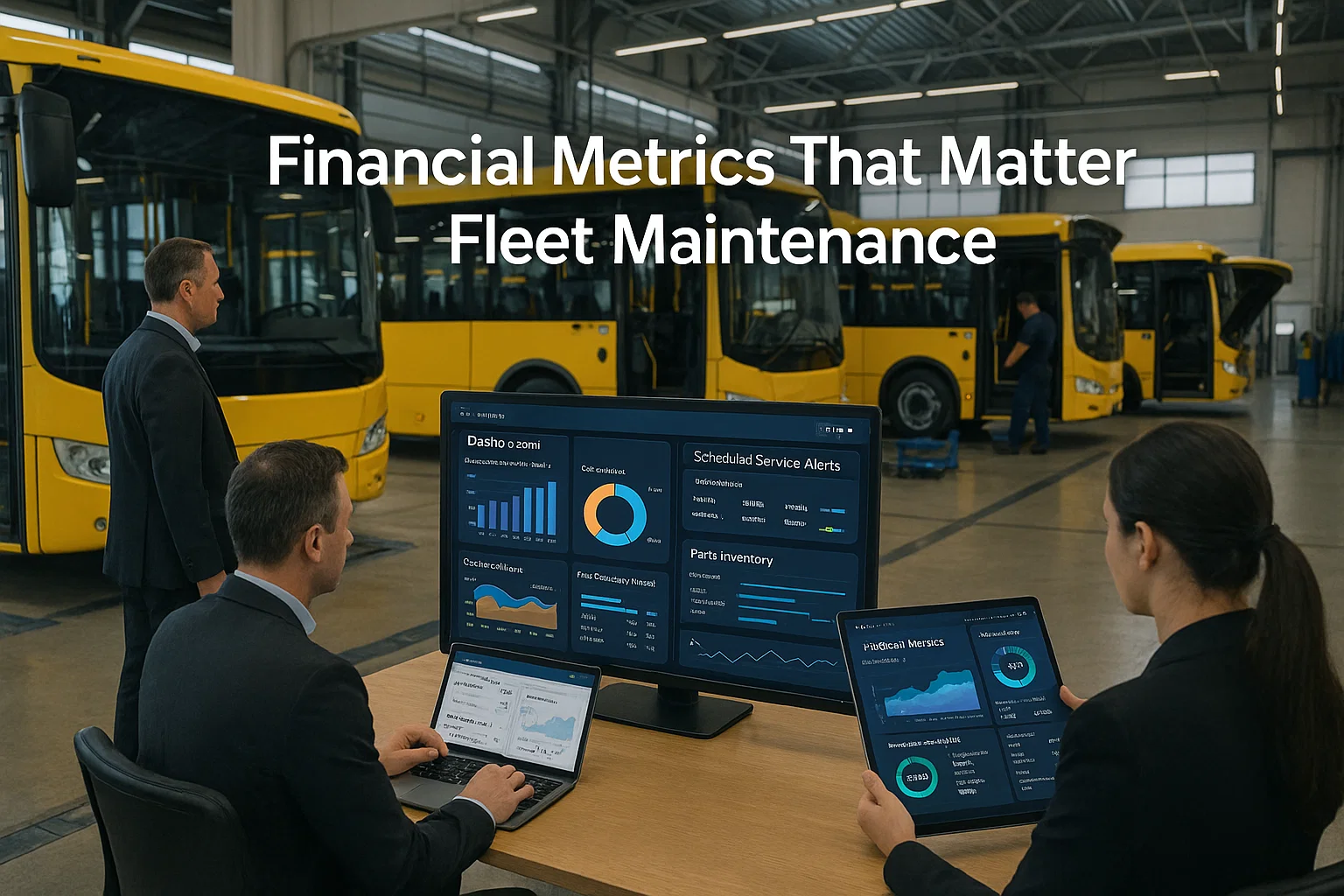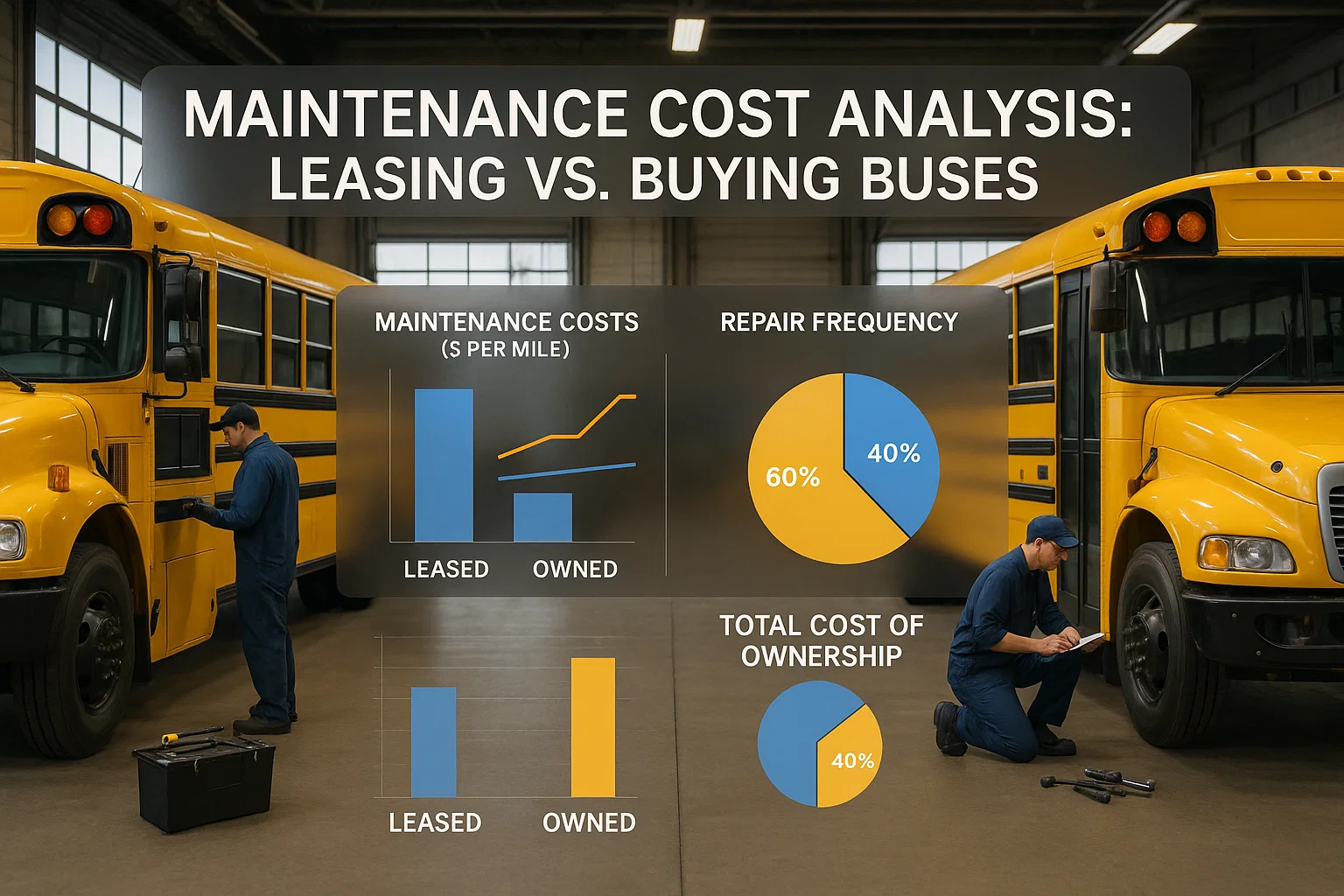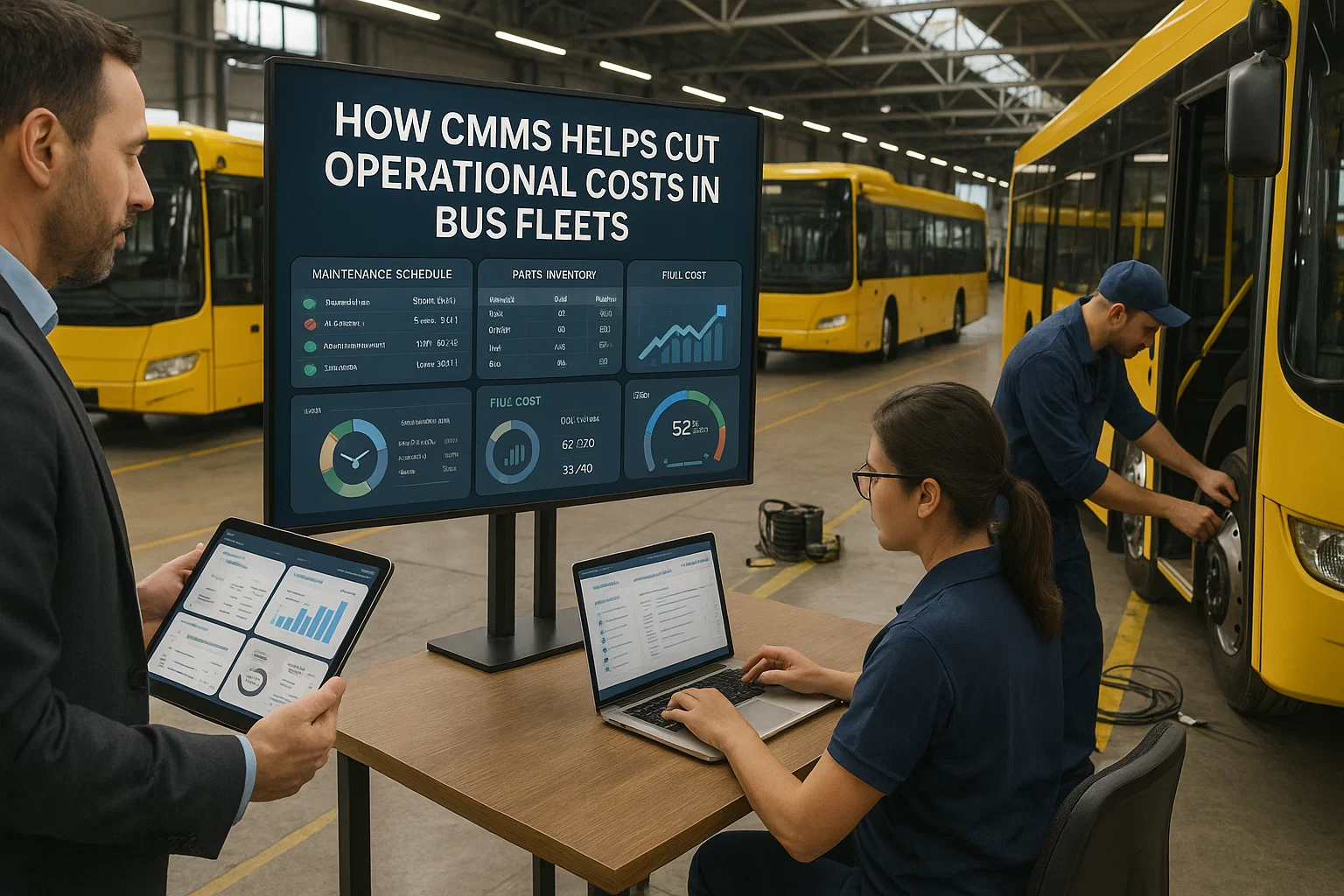Fleet maintenance represents one of the largest operational expenses for transportation organizations, yet many fleet managers struggle to measure and optimize their financial performance effectively. Modern fleet management software platforms transform raw maintenance data into actionable financial insights that drive strategic decision-making and demonstrate clear return on investment. Understanding which metrics truly matter enables fleet operators to justify budgets, identify cost-saving opportunities, and prove the value of preventive maintenance programs.
Modern fleet operations generate vast amounts of financial data across maintenance activities, parts inventory, labor costs, and vehicle lifecycle management. Without proper metrics and reporting systems, this data remains fragmented and underutilized, leading to reactive spending and missed optimization opportunities. Computerized maintenance solutions consolidate this information into comprehensive dashboards that reveal the true cost drivers behind fleet operations, enabling data-driven strategies that reduce expenses while improving service quality.
Industry leaders using advanced CMMS reporting capabilities achieve remarkable financial improvements: 35% reduction in maintenance costs, 40% decrease in inventory carrying costs, 25% improvement in technician productivity, and 50% reduction in vehicle downtime costs. These metrics demonstrate how proper financial tracking and analysis transform maintenance from a cost center into a strategic advantage that directly impacts organizational profitability.
Start Tracking Your Fleet Financial Performance
Implement proven financial metrics to optimize your maintenance costs today.
Getting StartedBook a Demo
Core Financial KPIs for Fleet Maintenance
Effective fleet financial management requires tracking key performance indicators that provide actionable insights into maintenance efficiency and cost optimization opportunities. Fleet maintenance platforms automatically calculate and monitor these critical metrics, transforming complex data into clear performance indicators that guide strategic decisions.
Cost Per Mile (CPM) Analysis
Cost per mile serves as the fundamental metric for fleet financial performance, encompassing all maintenance-related expenses divided by total miles traveled. This comprehensive metric includes parts, labor, outsourced services, and indirect costs, providing a single number that benchmarks performance across vehicles, routes, and time periods. Advanced maintenance management systems segment CPM by vehicle type, age, and usage patterns to identify optimization opportunities.
Tracking CPM trends reveals whether maintenance strategies effectively control costs as vehicles age. Sudden CPM increases signal emerging problems requiring intervention, while gradual improvements validate preventive maintenance investments. Fleet managers use CPM data to make informed decisions about vehicle replacement timing, route assignments, and maintenance scheduling priorities.
Total Cost of Ownership (TCO)
Total cost of ownership extends beyond purchase price to encompass all expenses throughout a vehicle's lifecycle. Digital maintenance platforms track acquisition costs, maintenance expenses, fuel consumption, insurance, depreciation, and disposal values to calculate true ownership costs. This comprehensive view enables strategic fleet planning that optimizes both capital and operational budgets.
Critical Financial Warning Indicators
Budget Deviation Alerts
- Maintenance Cost Overruns: Track when actual expenses exceed budgeted amounts by predefined thresholds
- Parts Inventory Imbalances: Monitor excess inventory carrying costs and stockout-related emergency purchases
- Labor Efficiency Declines: Identify when technician productivity falls below established benchmarks
- Warranty Recovery Gaps: Alert when warranty-eligible repairs aren't properly claimed
- Vendor Price Increases: Flag unusual cost escalations from suppliers requiring negotiation
Early detection of financial anomalies through automated monitoring systems prevents minor issues from becoming major budget problems. Automated alerts notify managers when spending patterns deviate from historical norms or established thresholds, enabling rapid corrective action before costs spiral out of control.
Predictive Cost Modeling
Advanced analytics within fleet management software use historical data to predict future maintenance costs with remarkable accuracy. Machine learning algorithms analyze patterns in component failures, seasonal variations, and vehicle aging to forecast upcoming expenses. This predictive capability transforms budget planning from guesswork into data-driven precision.
Maintenance ROI Measurement
Quantifying the return on investment for maintenance activities proves the value of preventive programs and justifies resource allocation. Maintenance tracking systems monitor the financial impact of maintenance strategies by comparing preventive maintenance costs against avoided breakdown expenses, extended asset life, and improved operational efficiency.
Preventive vs. Reactive Cost Analysis
Preventive Maintenance Metrics
Track scheduled service costs, planned downtime impact, and resource utilization rates to optimize PM programs
Reactive Maintenance Costs
Monitor emergency repair expenses, unplanned downtime losses, and overtime labor premiums
Cost Avoidance Calculations
Quantify savings from prevented breakdowns, extended component life, and improved fuel efficiency
Studies show that preventive maintenance costs 3-9 times less than reactive repairs when considering all associated expenses. Schedule a demo to see how platforms document these savings through detailed cost tracking that captures both direct repair expenses and indirect costs like service disruptions, customer dissatisfaction, and reputation damage.
Labor Cost Optimization Metrics
Labor represents 50-70% of total maintenance costs, making workforce productivity crucial for financial performance. Fleet optimization tools track technician efficiency, overtime utilization, and skill development to optimize labor investments while maintaining service quality.
Key Labor Performance Indicators
- Wrench Time Analysis: Measure productive time versus administrative tasks to maximize technician efficiency
- First-Time Fix Rate: Track repairs completed correctly initially to avoid costly rework
- Overtime Percentage: Monitor premium labor costs to identify staffing imbalances
- Training ROI: Quantify productivity improvements from skill development investments
- Outsourcing vs. In-House Analysis: Compare internal labor costs against vendor pricing for optimal sourcing decisions
Optimizing labor metrics through workforce management solutions reduces costs while improving job satisfaction. Automated scheduling matches technician skills with maintenance requirements, minimizing overtime while ensuring critical repairs receive appropriate expertise.
Optimize Your Maintenance Financial Strategy
Discover how data-driven financial metrics can reduce your fleet costs by 30-40%.
Getting StartedBook a Demo
Inventory Financial Management
Parts inventory ties up significant capital while stockouts cause expensive downtime and emergency purchases. Inventory management modules optimize stock levels through sophisticated algorithms that balance carrying costs against service level requirements.
Inventory Turnover Metrics
Inventory turnover ratio measures how efficiently parts investment generates maintenance value. High turnover indicates effective inventory management, while low turnover suggests excess stock tying up working capital. Digital inventory systems calculate turnover by part category, enabling targeted optimization of slow-moving items while maintaining critical component availability.
Advanced analytics identify obsolete inventory requiring disposal, predict seasonal demand variations, and recommend optimal reorder points. Integration with supplier systems enables just-in-time ordering that reduces carrying costs while preventing stockouts.
Warranty Recovery Tracking
Warranty recovery represents significant unrealized savings for many fleets. Automated warranty tracking platforms automatically flag eligible repairs and document claims to maximize recovery rates. Fleets typically recover 15-25% of parts costs through improved warranty management.
Downtime Cost Analysis
Vehicle downtime creates cascading financial impacts beyond repair costs, including lost revenue, customer dissatisfaction, and substitute vehicle expenses. Downtime tracking systems quantify total downtime costs to justify preventive maintenance investments and prioritize repair activities.
Comprehensive Downtime Metrics
Direct Downtime Costs
Calculate lost revenue, substitute vehicle rental, and expedited shipping charges
Indirect Impact Measurement
Estimate customer attrition, reputation damage, and service level agreement penalties
Opportunity Cost Analysis
Quantify missed business opportunities and competitive disadvantages from reduced fleet availability
Understanding true downtime costs transforms maintenance prioritization. Fleet analytics platforms rank repairs based on financial impact rather than just technical urgency, ensuring resources focus on activities that maximize fleet availability and revenue generation.
Lifecycle Cost Management
Strategic lifecycle management optimizes the balance between capital investments and operational expenses. Asset management platforms track comprehensive lifecycle costs to determine optimal replacement timing that minimizes total fleet expenses while maintaining service reliability.
Replacement Decision Analytics
- Economic Life Calculation: Determine when rising maintenance costs exceed replacement economics
- Residual Value Tracking: Monitor depreciation curves to maximize disposal timing
- Capital Planning Integration: Forecast replacement needs for long-term budget planning
- Lease vs. Buy Analysis: Compare ownership models using actual maintenance cost data
- Standardization Benefits: Quantify savings from fleet commonality in parts and training
Data-driven replacement decisions through lifecycle analytics tools prevent both premature disposal that wastes capital and excessive retention that inflates operating costs. The system recommends optimal replacement timing based on total cost minimization rather than arbitrary age or mileage thresholds.
Budget Planning and Forecasting
Accurate budget forecasting requires deep understanding of maintenance patterns, cost trends, and upcoming requirements. Budget planning modules leverage historical data and predictive analytics to create precise budget projections that align resources with operational needs.
Dynamic Budget Management
Historical Trend Analysis
Analyze multi-year spending patterns to identify seasonal variations and growth trends
Predictive Maintenance Forecasting
Project future maintenance requirements based on vehicle age, usage, and condition
Scenario Planning Tools
Model budget impacts of different maintenance strategies and service level targets
Rolling forecasts updated monthly through automated reporting systems provide early warning of budget variances, enabling proactive adjustments before year-end surprises. Integration with financial systems ensures maintenance budgets align with organizational financial planning.
Master Your Fleet Financial Metrics
Learn how leading fleets achieve 35% cost reduction through financial optimization.
Getting StartedBook a Demo
Vendor Performance Financial Metrics
External vendor management significantly impacts maintenance costs through pricing, quality, and service levels. Vendor management systems track supplier performance metrics that optimize relationships and reduce total procurement costs.
Supplier Cost Analysis
- Price Benchmarking: Compare vendor pricing against market rates and historical trends
- Quality Cost Tracking: Monitor warranty claims and rework rates by supplier
- Delivery Performance: Calculate downtime costs from late deliveries or stockouts
- Total Acquisition Cost: Include shipping, handling, and administrative costs in vendor comparisons
- Contract Compliance: Verify billing accuracy and contractual term adherence
Vendor scorecards generated by procurement optimization tools provide objective performance data for supplier negotiations. Documenting cost impacts from vendor performance issues strengthens negotiating positions and justifies supplier changes when necessary.
Regulatory Compliance Cost Management
Regulatory compliance creates both direct costs through inspections and certifications, and indirect costs through operational constraints. Compliance management platforms track expenses while preventing costly violations through automated scheduling and documentation.
Compliance Financial Impact
Direct Compliance Costs
Track inspection fees, certification expenses, and mandatory equipment upgrades
Violation Prevention Savings
Quantify avoided fines, penalties, and operational shutdowns through proactive compliance
Audit Preparation Efficiency
Reduce audit costs through automated documentation and instant report generation
Proactive compliance management through automated compliance tools typically reduces compliance-related costs by 30-40% while eliminating violation risks. The system maintains audit trails that satisfy regulatory requirements without manual documentation burden.
Fuel Management Financial Metrics
Fuel represents 20-40% of fleet operating costs, making consumption optimization critical for financial performance. Fuel management systems integrate with fleet platforms to track consumption patterns, identify inefficiencies, and reduce fuel expenses.
Fuel Efficiency Analytics
- Miles Per Gallon Tracking: Monitor fuel efficiency by vehicle, route, and driver
- Idle Time Costs: Calculate wasted fuel from excessive idling behaviors
- Route Optimization Savings: Quantify fuel reductions from improved routing
- Maintenance Impact Analysis: Correlate maintenance activities with fuel consumption changes
- Alternative Fuel ROI: Compare traditional versus alternative fuel total costs
Fuel analytics through fleet efficiency platforms identify 10-15% savings opportunities through driver training, route optimization, and maintenance improvements. Real-time monitoring alerts managers to unusual consumption patterns requiring investigation.
Technology ROI Measurement
Quantifying the return on investment for fleet technology implementation demonstrates value and guides future investments. Comprehensive ROI analysis captures both hard cost savings and soft benefits like improved safety and compliance.
CMMS Investment Returns
Organizations implementing digital fleet solutions typically achieve payback within 12-18 months through multiple benefit streams. Direct cost savings from optimized maintenance, reduced downtime, and improved inventory management provide immediate returns. Indirect benefits including better compliance, enhanced safety, and improved customer satisfaction create long-term value.
Quantifiable Savings
35% maintenance cost reduction, 40% inventory optimization, 25% labor efficiency improvement
Productivity Gains
50% reduction in administrative time, 60% faster report generation, 30% improved technician utilization
Risk Mitigation Value
Eliminated compliance violations, reduced accident rates, minimized liability exposure
Financial Reporting Best Practices
Effective financial reporting transforms raw data into actionable insights that drive strategic decisions. Reporting automation platforms provide customizable dashboards and automated reports that deliver the right information to the right stakeholders at the right time.
Executive Dashboard Design
Executive dashboards focus on high-level metrics that demonstrate maintenance impact on organizational objectives. Key performance indicators include total cost of ownership trends, fleet availability rates, and budget variance analysis. Visualization tools present complex data through intuitive charts that highlight performance against targets.
Operational Report Automation
Daily operational reports provide managers with detailed metrics for immediate decision-making. Automated report generation through fleet reporting systems ensures consistent information delivery without manual effort. Reports include work order backlogs, technician productivity, parts usage, and cost trends.
Frequently Asked Questions
How does Bus CMMS improve fleet financial performance?
Fleet financial optimization software revolutionizes performance through comprehensive cost visibility, predictive analytics, and automated optimization across all maintenance operations. The platform captures every maintenance-related expense in real-time, from parts and labor to vendor services and downtime impacts, providing unprecedented insight into true operational costs. Advanced analytics identify cost-saving opportunities that manual tracking would never reveal, such as optimal replacement timing that balances capital and operating expenses, inventory optimization that reduces carrying costs while preventing stockouts, and labor scheduling that minimizes overtime while maintaining service levels. Automated financial tracking eliminates costly human errors in warranty tracking, ensures compliance to avoid violations, and provides predictive maintenance that prevents expensive emergency repairs. The system's financial dashboards give executives clear visibility into maintenance ROI, enabling data-driven decisions that reduce total costs by 30-40% while improving fleet reliability. Integration with financial systems ensures maintenance data flows seamlessly into budgeting and planning processes, while real-time financial alerts notify managers of cost overruns before they impact bottom-line results. This comprehensive financial management capability transforms maintenance from an unpredictable expense into a controlled, optimized operation that consistently delivers value.
What ROI can fleet operators expect from Bus CMMS implementation?
Fleet operators implementing comprehensive maintenance management solutions consistently achieve remarkable returns on investment, with most organizations reaching payback within 12-18 months and ongoing annual returns of 200-400%. Direct cost reductions provide immediate value: maintenance expenses decrease by 35% through optimized scheduling and preventive strategies, inventory costs drop 40% through better stock management, labor efficiency improves 25% via automated workflows, and fuel costs reduce 10-15% through consumption monitoring. Digital fleet optimization also delivers significant indirect savings through 50% reduction in vehicle downtime that maintains revenue generation, eliminated compliance violations that prevent costly fines and shutdowns, improved warranty recovery that captures 15-25% of parts costs, and extended vehicle life that defers capital expenditures by 2-3 years. Beyond pure cost savings, the platform creates competitive advantages through improved customer satisfaction from reliable service, enhanced safety records that reduce insurance premiums, better employee retention through improved working conditions, and strategic insights that guide long-term fleet planning. Organizations report total annual savings ranging from $100,000 for small fleets to several million dollars for large operations. The comprehensive ROI package extends beyond financial metrics to include risk mitigation, regulatory compliance, and operational excellence that positions fleets for sustainable success in competitive markets.
Transform Your Fleet's Financial Future
Join industry leaders achieving 30-40% cost reduction with advanced financial metrics.
Getting StartedBook a Demo
Conclusion
Financial metrics form the foundation of successful fleet maintenance management, transforming operational data into strategic insights that drive profitability and efficiency. Through comprehensive tracking and analysis capabilities, modern fleet management platforms empower managers to move beyond reactive cost management toward proactive financial optimization that delivers measurable results.
The metrics explored throughout this analysisâ€"from cost per mile and total ownership costs to labor efficiency and downtime impactsâ€"provide the visibility necessary for data-driven decision-making. Organizations that embrace these financial KPIs through advanced fleet solutions consistently achieve 30-40% cost reductions while improving service quality and regulatory compliance.
As fleet operations face increasing pressure to demonstrate value and control costs, the ability to measure, analyze, and optimize financial performance becomes a competitive necessity. Modern maintenance management technology provides the tools and insights needed to transform maintenance from a cost center into a strategic advantage that directly contributes to organizational success.
Ready to Optimize Your Fleet Financial Performance?
Discover how comprehensive financial metrics and reporting can optimize your fleet operations and deliver measurable ROI.
Fleet maintenance represents one of the largest operational expenses for transportation organizations, yet many fleet managers struggle to measure and optimize their financial performance effectively. Modern fleet management software platforms transform raw maintenance data into actionable financial insights that drive strategic decision-making and demonstrate clear return on investment. Understanding which metrics truly matter enables fleet operators to justify budgets, identify cost-saving opportunities, and prove the value of preventive maintenance programs.
Modern fleet operations generate vast amounts of financial data across maintenance activities, parts inventory, labor costs, and vehicle lifecycle management. Without proper metrics and reporting systems, this data remains fragmented and underutilized, leading to reactive spending and missed optimization opportunities. Computerized maintenance solutions consolidate this information into comprehensive dashboards that reveal the true cost drivers behind fleet operations, enabling data-driven strategies that reduce expenses while improving service quality.
Industry leaders using advanced CMMS reporting capabilities achieve remarkable financial improvements: 35% reduction in maintenance costs, 40% decrease in inventory carrying costs, 25% improvement in technician productivity, and 50% reduction in vehicle downtime costs. These metrics demonstrate how proper financial tracking and analysis transform maintenance from a cost center into a strategic advantage that directly impacts organizational profitability.
Start Tracking Your Fleet Financial Performance
Implement proven financial metrics to optimize your maintenance costs today.
Getting StartedBook a Demo
Core Financial KPIs for Fleet Maintenance
Effective fleet financial management requires tracking key performance indicators that provide actionable insights into maintenance efficiency and cost optimization opportunities. Fleet maintenance platforms automatically calculate and monitor these critical metrics, transforming complex data into clear performance indicators that guide strategic decisions.
Cost Per Mile (CPM) Analysis
Cost per mile serves as the fundamental metric for fleet financial performance, encompassing all maintenance-related expenses divided by total miles traveled. This comprehensive metric includes parts, labor, outsourced services, and indirect costs, providing a single number that benchmarks performance across vehicles, routes, and time periods. Advanced maintenance management systems segment CPM by vehicle type, age, and usage patterns to identify optimization opportunities.
Tracking CPM trends reveals whether maintenance strategies effectively control costs as vehicles age. Sudden CPM increases signal emerging problems requiring intervention, while gradual improvements validate preventive maintenance investments. Fleet managers use CPM data to make informed decisions about vehicle replacement timing, route assignments, and maintenance scheduling priorities.
Total Cost of Ownership (TCO)
Total cost of ownership extends beyond purchase price to encompass all expenses throughout a vehicle's lifecycle. Digital maintenance platforms track acquisition costs, maintenance expenses, fuel consumption, insurance, depreciation, and disposal values to calculate true ownership costs. This comprehensive view enables strategic fleet planning that optimizes both capital and operational budgets.
Critical Financial Warning Indicators
Budget Deviation Alerts
- Maintenance Cost Overruns: Track when actual expenses exceed budgeted amounts by predefined thresholds
- Parts Inventory Imbalances: Monitor excess inventory carrying costs and stockout-related emergency purchases
- Labor Efficiency Declines: Identify when technician productivity falls below established benchmarks
- Warranty Recovery Gaps: Alert when warranty-eligible repairs aren't properly claimed
- Vendor Price Increases: Flag unusual cost escalations from suppliers requiring negotiation
Early detection of financial anomalies through automated monitoring systems prevents minor issues from becoming major budget problems. Automated alerts notify managers when spending patterns deviate from historical norms or established thresholds, enabling rapid corrective action before costs spiral out of control.
Predictive Cost Modeling
Advanced analytics within fleet management software use historical data to predict future maintenance costs with remarkable accuracy. Machine learning algorithms analyze patterns in component failures, seasonal variations, and vehicle aging to forecast upcoming expenses. This predictive capability transforms budget planning from guesswork into data-driven precision.
Maintenance ROI Measurement
Quantifying the return on investment for maintenance activities proves the value of preventive programs and justifies resource allocation. Maintenance tracking systems monitor the financial impact of maintenance strategies by comparing preventive maintenance costs against avoided breakdown expenses, extended asset life, and improved operational efficiency.
Preventive vs. Reactive Cost Analysis
Preventive Maintenance Metrics
Track scheduled service costs, planned downtime impact, and resource utilization rates to optimize PM programs
Reactive Maintenance Costs
Monitor emergency repair expenses, unplanned downtime losses, and overtime labor premiums
Cost Avoidance Calculations
Quantify savings from prevented breakdowns, extended component life, and improved fuel efficiency
Studies show that preventive maintenance costs 3-9 times less than reactive repairs when considering all associated expenses. Schedule a demo to see how platforms document these savings through detailed cost tracking that captures both direct repair expenses and indirect costs like service disruptions, customer dissatisfaction, and reputation damage.
Labor Cost Optimization Metrics
Labor represents 50-70% of total maintenance costs, making workforce productivity crucial for financial performance. Fleet optimization tools track technician efficiency, overtime utilization, and skill development to optimize labor investments while maintaining service quality.
Key Labor Performance Indicators
- Wrench Time Analysis: Measure productive time versus administrative tasks to maximize technician efficiency
- First-Time Fix Rate: Track repairs completed correctly initially to avoid costly rework
- Overtime Percentage: Monitor premium labor costs to identify staffing imbalances
- Training ROI: Quantify productivity improvements from skill development investments
- Outsourcing vs. In-House Analysis: Compare internal labor costs against vendor pricing for optimal sourcing decisions
Optimizing labor metrics through workforce management solutions reduces costs while improving job satisfaction. Automated scheduling matches technician skills with maintenance requirements, minimizing overtime while ensuring critical repairs receive appropriate expertise.
Optimize Your Maintenance Financial Strategy
Discover how data-driven financial metrics can reduce your fleet costs by 30-40%.
Getting StartedBook a Demo
Inventory Financial Management
Parts inventory ties up significant capital while stockouts cause expensive downtime and emergency purchases. Inventory management modules optimize stock levels through sophisticated algorithms that balance carrying costs against service level requirements.
Inventory Turnover Metrics
Inventory turnover ratio measures how efficiently parts investment generates maintenance value. High turnover indicates effective inventory management, while low turnover suggests excess stock tying up working capital. Digital inventory systems calculate turnover by part category, enabling targeted optimization of slow-moving items while maintaining critical component availability.
Advanced analytics identify obsolete inventory requiring disposal, predict seasonal demand variations, and recommend optimal reorder points. Integration with supplier systems enables just-in-time ordering that reduces carrying costs while preventing stockouts.
Warranty Recovery Tracking
Warranty recovery represents significant unrealized savings for many fleets. Automated warranty tracking platforms automatically flag eligible repairs and document claims to maximize recovery rates. Fleets typically recover 15-25% of parts costs through improved warranty management.
Downtime Cost Analysis
Vehicle downtime creates cascading financial impacts beyond repair costs, including lost revenue, customer dissatisfaction, and substitute vehicle expenses. Downtime tracking systems quantify total downtime costs to justify preventive maintenance investments and prioritize repair activities.
Comprehensive Downtime Metrics
Direct Downtime Costs
Calculate lost revenue, substitute vehicle rental, and expedited shipping charges
Indirect Impact Measurement
Estimate customer attrition, reputation damage, and service level agreement penalties
Opportunity Cost Analysis
Quantify missed business opportunities and competitive disadvantages from reduced fleet availability
Understanding true downtime costs transforms maintenance prioritization. Fleet analytics platforms rank repairs based on financial impact rather than just technical urgency, ensuring resources focus on activities that maximize fleet availability and revenue generation.
Lifecycle Cost Management
Strategic lifecycle management optimizes the balance between capital investments and operational expenses. Asset management platforms track comprehensive lifecycle costs to determine optimal replacement timing that minimizes total fleet expenses while maintaining service reliability.
Replacement Decision Analytics
- Economic Life Calculation: Determine when rising maintenance costs exceed replacement economics
- Residual Value Tracking: Monitor depreciation curves to maximize disposal timing
- Capital Planning Integration: Forecast replacement needs for long-term budget planning
- Lease vs. Buy Analysis: Compare ownership models using actual maintenance cost data
- Standardization Benefits: Quantify savings from fleet commonality in parts and training
Data-driven replacement decisions through lifecycle analytics tools prevent both premature disposal that wastes capital and excessive retention that inflates operating costs. The system recommends optimal replacement timing based on total cost minimization rather than arbitrary age or mileage thresholds.
Budget Planning and Forecasting
Accurate budget forecasting requires deep understanding of maintenance patterns, cost trends, and upcoming requirements. Budget planning modules leverage historical data and predictive analytics to create precise budget projections that align resources with operational needs.
Dynamic Budget Management
Historical Trend Analysis
Analyze multi-year spending patterns to identify seasonal variations and growth trends
Predictive Maintenance Forecasting
Project future maintenance requirements based on vehicle age, usage, and condition
Scenario Planning Tools
Model budget impacts of different maintenance strategies and service level targets
Rolling forecasts updated monthly through automated reporting systems provide early warning of budget variances, enabling proactive adjustments before year-end surprises. Integration with financial systems ensures maintenance budgets align with organizational financial planning.
Master Your Fleet Financial Metrics
Learn how leading fleets achieve 35% cost reduction through financial optimization.
Getting StartedBook a Demo
Vendor Performance Financial Metrics
External vendor management significantly impacts maintenance costs through pricing, quality, and service levels. Vendor management systems track supplier performance metrics that optimize relationships and reduce total procurement costs.
Supplier Cost Analysis
- Price Benchmarking: Compare vendor pricing against market rates and historical trends
- Quality Cost Tracking: Monitor warranty claims and rework rates by supplier
- Delivery Performance: Calculate downtime costs from late deliveries or stockouts
- Total Acquisition Cost: Include shipping, handling, and administrative costs in vendor comparisons
- Contract Compliance: Verify billing accuracy and contractual term adherence
Vendor scorecards generated by procurement optimization tools provide objective performance data for supplier negotiations. Documenting cost impacts from vendor performance issues strengthens negotiating positions and justifies supplier changes when necessary.
Regulatory Compliance Cost Management
Regulatory compliance creates both direct costs through inspections and certifications, and indirect costs through operational constraints. Compliance management platforms track expenses while preventing costly violations through automated scheduling and documentation.
Compliance Financial Impact
Direct Compliance Costs
Track inspection fees, certification expenses, and mandatory equipment upgrades
Violation Prevention Savings
Quantify avoided fines, penalties, and operational shutdowns through proactive compliance
Audit Preparation Efficiency
Reduce audit costs through automated documentation and instant report generation
Proactive compliance management through automated compliance tools typically reduces compliance-related costs by 30-40% while eliminating violation risks. The system maintains audit trails that satisfy regulatory requirements without manual documentation burden.
Fuel Management Financial Metrics
Fuel represents 20-40% of fleet operating costs, making consumption optimization critical for financial performance. Fuel management systems integrate with fleet platforms to track consumption patterns, identify inefficiencies, and reduce fuel expenses.
Fuel Efficiency Analytics
- Miles Per Gallon Tracking: Monitor fuel efficiency by vehicle, route, and driver
- Idle Time Costs: Calculate wasted fuel from excessive idling behaviors
- Route Optimization Savings: Quantify fuel reductions from improved routing
- Maintenance Impact Analysis: Correlate maintenance activities with fuel consumption changes
- Alternative Fuel ROI: Compare traditional versus alternative fuel total costs
Fuel analytics through fleet efficiency platforms identify 10-15% savings opportunities through driver training, route optimization, and maintenance improvements. Real-time monitoring alerts managers to unusual consumption patterns requiring investigation.
Technology ROI Measurement
Quantifying the return on investment for fleet technology implementation demonstrates value and guides future investments. Comprehensive ROI analysis captures both hard cost savings and soft benefits like improved safety and compliance.
CMMS Investment Returns
Organizations implementing digital fleet solutions typically achieve payback within 12-18 months through multiple benefit streams. Direct cost savings from optimized maintenance, reduced downtime, and improved inventory management provide immediate returns. Indirect benefits including better compliance, enhanced safety, and improved customer satisfaction create long-term value.
Quantifiable Savings
35% maintenance cost reduction, 40% inventory optimization, 25% labor efficiency improvement
Productivity Gains
50% reduction in administrative time, 60% faster report generation, 30% improved technician utilization
Risk Mitigation Value
Eliminated compliance violations, reduced accident rates, minimized liability exposure
Financial Reporting Best Practices
Effective financial reporting transforms raw data into actionable insights that drive strategic decisions. Reporting automation platforms provide customizable dashboards and automated reports that deliver the right information to the right stakeholders at the right time.
Executive Dashboard Design
Executive dashboards focus on high-level metrics that demonstrate maintenance impact on organizational objectives. Key performance indicators include total cost of ownership trends, fleet availability rates, and budget variance analysis. Visualization tools present complex data through intuitive charts that highlight performance against targets.
Operational Report Automation
Daily operational reports provide managers with detailed metrics for immediate decision-making. Automated report generation through fleet reporting systems ensures consistent information delivery without manual effort. Reports include work order backlogs, technician productivity, parts usage, and cost trends.
Frequently Asked Questions
How does Bus CMMS improve fleet financial performance?
Fleet financial optimization software revolutionizes performance through comprehensive cost visibility, predictive analytics, and automated optimization across all maintenance operations. The platform captures every maintenance-related expense in real-time, from parts and labor to vendor services and downtime impacts, providing unprecedented insight into true operational costs. Advanced analytics identify cost-saving opportunities that manual tracking would never reveal, such as optimal replacement timing that balances capital and operating expenses, inventory optimization that reduces carrying costs while preventing stockouts, and labor scheduling that minimizes overtime while maintaining service levels. Automated financial tracking eliminates costly human errors in warranty tracking, ensures compliance to avoid violations, and provides predictive maintenance that prevents expensive emergency repairs. The system's financial dashboards give executives clear visibility into maintenance ROI, enabling data-driven decisions that reduce total costs by 30-40% while improving fleet reliability. Integration with financial systems ensures maintenance data flows seamlessly into budgeting and planning processes, while real-time financial alerts notify managers of cost overruns before they impact bottom-line results. This comprehensive financial management capability transforms maintenance from an unpredictable expense into a controlled, optimized operation that consistently delivers value.
What ROI can fleet operators expect from Bus CMMS implementation?
Fleet operators implementing comprehensive maintenance management solutions consistently achieve remarkable returns on investment, with most organizations reaching payback within 12-18 months and ongoing annual returns of 200-400%. Direct cost reductions provide immediate value: maintenance expenses decrease by 35% through optimized scheduling and preventive strategies, inventory costs drop 40% through better stock management, labor efficiency improves 25% via automated workflows, and fuel costs reduce 10-15% thro







